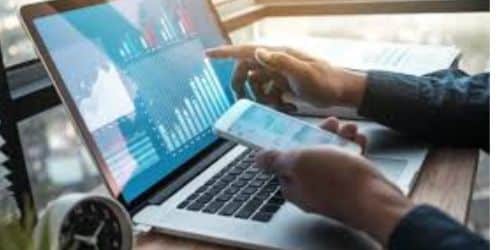MDM solutions are becoming increasingly popular as businesses look for a way to manage their mobile devices. An MDM solution can provide the necessary MDM security and functionality to keep mobile devices safe and secure. Similarly, it can also help businesses comply with regulations and maintain employee productivity. In this article, we will explore the best mobile device management (MDM) solutions available on the market today. In addition, this guide will review their features and benefits and discuss the advantages and disadvantages of each. By understanding MDM security, and how MDM solutions or software work, such as Microsoft and Apple MDM Solutions, businesses can make informed decisions on which one is best suited for their mobile strategy.
What Is an MDM Solution?
MDM stands for Mobile Device Management. An MDM solution is a software solution that allows organizations to manage the mobile devices used within their infrastructure. However, it provides centralized control and management capabilities for smartphones, tablets, and other mobile devices, regardless of their operating system (iOS, Android, Windows, etc.).
An MDM solution enables IT administrators to enforce security policies, configure device settings, distribute applications, deploy updates, and perform various other device management tasks remotely. Therefore, secure corporate-owned, corporate-liable, and bring-your-own-device (BYOD) scenarios. It helps organizations enhance productivity, streamline device deployment and management processes, ensure data security, and enforce compliance with corporate policies.
Additionally, an MDM solution may include features like remote lock and wipe, device tracking, app management, content management, and access control, providing comprehensive control and visibility over the mobile devices within an organization’s network.
Furthermore, an MDM solution helps organizations effectively manage and secure their mobile devices, enhance employee productivity, and mitigate potential risks associated with mobile device usage.
The Best Mobile Device Management (MDM) Solutions
The landscape of Mobile Device Management (MDM) solutions is constantly evolving, with new advancements and features being introduced regularly. In 2023, several MDM solutions will emerge as frontrunners in the market, offering comprehensive features, robust security, and seamless integration capabilities. Here are the best MDM software solutions for 2023:
#1. MobileIron
When it comes to the best MDM software. MobileIron is a leading MDM solution. It is known for its robust security features and advanced device management capabilities. As the best MDM software solution, it offers a unified endpoint management (UEM) platform that supports a wide range of mobile devices, including smartphones, tablets, and IoT devices. MobileIron provides features such as app management, content management, identity management, and secure browsing to ensure data protection and compliance.
Pros:
- Robust security features: MobileIron is known for its advanced security measures, ensuring data protection and compliance.
- Comprehensive device management: It offers a unified endpoint management platform, supporting a wide range of mobile devices and providing features like app management, content management, and identity management.
- Integration capabilities: MobileIron seamlessly integrates with existing IT infrastructures, making it easier to manage devices and enforce security policies.
Cons:
- Steeper learning curve: Some users may find MobileIron’s interface and configuration options initially complex and require time to become familiar with the system.
- Higher cost: MobileIron’s advanced feature set and security measures may come at a higher price point, making it less accessible for smaller organizations with limited budgets.
#2. VMware Workspace ONE
VMware Workspace ONE is another best MDM software. It is a powerful MDM solution that combines device management, application management, and identity management into a unified platform. However, Workspace ONE provides a user-friendly interface, allowing IT administrators to manage devices, deploy applications, and enforce security policies with ease.
Pros:
- Unified platform: Workspace ONE combines device management, application management, and identity management into a single platform, simplifying administration and providing a seamless user experience.
- Multi-platform support: As an MDM solution for Android, it supports the integration of various operating systems, including iOS, Android, Windows, and macOS, enabling organizations to manage a diverse range of devices.
- Integration with VMware ecosystem: Workspace ONE seamlessly integrates with other VMware products, leveraging existing infrastructure investments and streamlining management processes.
Cons:
- Complex setup: Setting up and configuring Workspace ONE may require more technical expertise, especially when integrating with complex IT environments.
- Limited customization: Some users have noted limitations in customization options, which may restrict certain specific configurations based on organizational requirements.
#3. AirDroid Business
AirDroid Business is a comprehensive mobile device management (MDM) solution that offers a range of features to help businesses effectively manage and control their fleet of Android devices. It provides a secure and efficient way to remotely manage, monitor, and troubleshoot Android devices, making it an ideal solution for businesses of all industries, like retail, healthcare, digital signage, transportation and logistics, IT and MSP, and education.
Pros:
Unify Platform: Makes it easy for IT admins to remotely manage and control, install and update applications, set kiosk mode and policy, and manage files all from a centralized dashboard.
Robust Security Features: Allows admins to enforce security policies, such as password requirements and device restrictions, to prevent unauthorized access and enhance data security. Additionally, Black Screen Mode will enable a privacy mode during remote control sessions.
Real-time Monitoring and Tracking: Keep an eye on device usage, location, and performance and enable businesses to identify and address any potential issues promptly, ensuring smooth operations and minimizing downtime.
Cons:
Limited systems supported: AirDroid Business only focuses on managing Android devices for now.
Additional costs for advanced features: Some advanced features may require additional licensing or incur extra costs, depending on the specific requirements of the business.
#4. Microsoft Intune
Microsoft Intune is another best MDM software to watch out for in the industry. It is a comprehensive cloud-based Microsoft Mdm Solution and MDM solution for Android that integrates seamlessly with the Microsoft ecosystem. Moreso, it enables organizations to manage and secure mobile devices, apps, and data from a centralized console. With the Microsoft MDM solution and its integration with Azure Active Directory, Intune provides robust identity and access management capabilities.
Pros:
- Integration with Microsoft ecosystem: Intune integrates seamlessly with other Microsoft products, such as Azure Active Directory, providing a cohesive solution for managing devices, apps, and data within the Microsoft ecosystem.
- Cloud-based management: As a cloud-based Microsoft Mdm Solution, Intune offers flexibility and scalability, allowing for easy device management across different locations and enabling remote management capabilities.
- Tight security integration: Intune leverages Microsoft Mdm Solution’s robust security infrastructure, offering advanced security features like conditional access and data protection.
Cons:
- Limited non-Microsoft platform support: While Intune supports major operating systems like iOS and Android, its feature set and capabilities may be more optimized for Microsoft devices and platforms.
- Complex licensing model: Microsoft Intune’s licensing structure can be complex, especially for organizations with diverse device ownership models and license management requirements.
#5. IBM MaaS360
IBM MaaS360 is a feature-rich MDM solution that offers a wide range of device management and security features. It supports multiple platforms, including iOS, Android, Windows, and macOS, and provides functionalities such as device enrollment, application management, content management, and threat protection. Furthermore, MaaS360 also offers advanced analytics and reporting capabilities, allowing organizations to gain insights into their mobile device usage and security posture.
Pros:
- Multi-platform support: MaaS360 supports a wide range of platforms, including iOS, Android, Windows, and macOS, allowing organizations to manage diverse device fleets.
- Advanced analytics and reporting: MaaS360 offers comprehensive analytics and reporting capabilities, providing valuable insights into device usage, security vulnerabilities, and compliance status.
- Extensive feature set: It provides a broad range of device management and security features, including enrollment, application management, content management, and threat protection.
Cons:
- Interface complexity: Some users may find MaaS360’s user interface and configuration options overwhelming, requiring additional time for IT administrators to become proficient in its usage.
- Support responsiveness: There have been occasional reports of delayed or subpar customer support experiences, which may impact issue resolution and user satisfaction.
#6. Citrix Endpoint Management
Citrix Endpoint Management, formerly known as XenMobile. It is an Android MDM solution that integrates device control, application management, and content collaboration.
Pros:
- Unified platform for device and app management: Citrix Endpoint Management combines device management, application management, and content collaboration, providing a comprehensive solution.
- Cross-platform compatibility: It supports various operating systems, allowing organizations to manage and secure devices running iOS, Android, Windows, and macOS.
- Enhanced visibility and control: Citrix Endpoint Management offers comprehensive analytics and reporting capabilities, enabling IT administrators to gain insights into device usage and security status.
Cons:
- Initial setup complexity: The initial setup and configuration of Citrix Endpoint Management can be complex, requiring technical expertise and possibly external assistance.
- Advanced features may require additional licensing: Some advanced features and functionalities may require additional licensing, potentially increasing the overall cost for organizations with specific requirements.
#7. Apple MDM Solution:
Apple MDM Solution, also known as Apple Business Manager. However, Apple School Manager provides a comprehensive set of tools and features specifically designed for managing Apple devices in business and education environments. Let’s explore the pros and cons of Apple MDM Solution:
Pros:
- Seamless integration with Apple devices: Apple MDM Solution is specifically designed to manage Apple devices.
- With Apple MDM Solution, organizations can streamline device deployment and setup processes, including over-the-air device enrollment.
- Granular control and configuration options: Apple MDM Solution offers extensive management capabilities, allowing administrators to enforce security policies, configure device settings, distribute applications, and remotely manage devices with precision.
Cons:
- Limited cross-platform support: Apple MDM Solution primarily focuses on managing Apple devices.
- Apple MDM Solution relies on the Apple ecosystem, including Apple Business Manager and Apple School Manager.
Why Is Mdm Solution Needed?
An MDM solution is needed to enhance the security, management, and productivity of mobile devices in an organization. Therefore, it helps streamline operations, reduce risks, and ensure compliance with regulations. Ultimately improving the overall efficiency and effectiveness of mobile device usage within the organization.
An MDM solution is needed for several reasons:
#1. Security:
Mobile devices are susceptible to security threats such as data breaches, malware attacks, and unauthorized access. MDM solutions let companies enforce security standards, modify device settings, and remotely delete or lock lost or stolen devices. It helps protect sensitive data and ensure compliance with security regulations.
#2. Device Management:
Organizations often deploy a large number of mobile devices across their network. Managing these devices manually can be time-consuming and prone to errors. Additionally, an MDM solution provides a central platform to remotely monitor and manage all devices, making it easier to handle tasks like device provisioning, software updates, and application management.
#3. Productivity:
With an MDM solution, IT administrators can remotely configure and deploy applications, settings, and resources to mobile devices. This ensures that employees have the necessary tools and access to corporate resources, increasing their productivity and efficiency.
#4. Cost Savings:
By enabling remote management and automation of device-related tasks, an MDM solution helps organizations reduce IT support costs and streamline operational processes. It eliminates the need for manual device setup, configuration, and troubleshooting, thereby saving time and resources.
#5. Compliance:
Many industries have specific regulations and standards around data privacy, security, and device usage. Furthermore, an MDM solution helps organizations meet these compliance requirements by enforcing security policies, managing access controls, and tracking device usage.
What Are the Four Types of Mdm?
Each type of MDM solution has its own advantages and considerations. The choice of either MDM solution for Android or Microsoft MDM solution depends on the specific needs, security requirements, and device ownership models of the organization.
There are four types of MDM solutions commonly used:
#1. Agent-based MDM:
This type of MDM solution requires the installation of a dedicated agent or client app on each mobile device. The agent enables communication between the device and the MDM server, allowing administrators to remotely manage and control the device. Agent-based MDM offers comprehensive management capabilities but requires device-level control and configuration.
#2. Agentless MDM:
In agentless MDM, no agent or client app needs to be installed on the mobile device. Instead, the MDM solution relies on the built-in management and control capabilities provided by the device’s operating system. Agentless MDM is typically limited to managing certain aspects like email configuration, security policies, and app distribution, without full device control.
#3. Containerization MDM:
Containerization separates business data and applications from personal data on a mobile device. A secure container is created to store corporate apps and data, ensuring that they are isolated and protected. Containerization MDM controls and manages the corporate container on the device while protecting personal apps and data.
#4. Dual Persona MDM:
Dual persona MDM creates separate work and personal environments on a mobile device. It provides a distinct work profile or space for all corporate data and apps while keeping personal data separate. This allows organizations to have control over the work profile, including security policies, app management, and data access, without interfering with the personal side of the device.
What Are the 3 Types of Master Data?
- Reference Data (or Domain Values): data that establishes and enforces acceptable values of a particular data element. Examples include a list of countries, a list of product categories, or a list of statuses such as “active” or “inactive”.
- Structural Data: data that defines relationships between different data elements, such as product hierarchy (for instance, a laptop is part of a PC which is part of a computer), accounting hierarchies (for instance, the balance sheet), or relationships between different entities such as customers and suppliers.
- Descriptive Data: data that provides information on an entity or a thing. Examples include address information, customer details, product details, or pricing information.
See Also WHAT IS MDM: Definition & What You Should Know
Conclusion
MDM Security is a great solution for businesses in need of highly secure mobile device management. Mdm Security offers a wide range of features and benefits, including data leakage protection, secure updates, and device configuration support. Its cloud-based platform makes it easy to remotely manage a wide variety of devices. In a nutshell, its level of support for the ever-changing landscape of mobile technology, from Android to iOS, means it has you covered no matter what platform you’re on. Finally, MDM Security is an excellent choice for businesses who need the latest in mobile protection and security solutions.
MDM Solutions FAQs
What Is an Example of Mdm?
MDM (Mobile Device Management) helps IT teams manage corporate cell phones, tablets, and other mobile devices securely and efficiently. Examples of MDM systems include Apple’s iPhone Configuration Utility, Cisco Meraki, AirWatch, Soti, Maas360, MobileIron, and Blackberry.
Is Mdm an App?
No, Mdm is not an app. MDM stands for Mobile Device Management, which is a type of software used to manage smartphones, tablets, and other mobile devices in an organization’s network.
Related Articles
- WHAT IS MDM: Definition & What You Should Know
- MASTER DATA MANAGEMENT TOOLS: Best Data Management Tools
- BYOD POLICY: Best Practices for Your Network Security in 2023
- HUMAN CAPITAL MANAGEMENT (HCM): Types, Examples & Software Solutions
- MOBILE DEVICE MANAGEMENT TOOLS: Meaning, Free and Best Tools [2023]






